|
History of Federal Weather Services in Central Illinois
| Early 1800s: Weather observations were taken at several military forts and private citizens around Illinois. The observation form at right was from September 1823 at Fort Edwards, along the Mississippi River near the town of Warsaw in present-day Hancock County. Some of the earliest reporting stations in central Illinois were at Athens (1843) and Jacksonville (1849). |
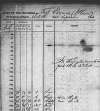
|
|
|

|
1849: The Smithsonian Institution supplied weather instruments to telegraph companies, and established an extensive nationwide observation network. Observations were submitted by telegraph to the Smithsonian, where weather maps were created. The network of 150 volunteers in 1849 grew to over 500 by 1860, before the start of the Civil War. The image at left is from the Galesburg station in February 1861.
|
|
| December 1855: Weather observations began in Peoria, by Dr. Frederick Brendel. These observations were first taken at a building at the intersection of Washington and East Franklin Sts. Dr. Brendel made nearly continuous temperature and precipitation readings through 1905. These observations serve as the backbone of the Peoria climatological database. |
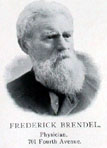
|
|
February 1, 1865: A Smithsonian weather observing station was established in Springfield, with George M. Brinkerhoff as observer. According to the observations that day, it was 40 degrees at 7 AM, 45 degrees at 2 PM, and 41 degrees at 9 PM; a steady drizzle fell most of the day. Daily weather observations continue through August 1870. These observations were taken at the Brinkerhoff house located on N. 5th St. near Keys Ave.
|
|

|
February 9, 1870: The U.S. Congress authorized the War Department to take weather observations at key marine ports, assigning this function to the Army Signal Service. The intention was to provide advanced warning of storm systems that could adversely affect marine interests. This service was the forerunner to NOAA's National Weather Service. The official name at the time was "The Division of Telegrams and Reports for the Benefit of Commerce." Weather forecasts for central Illinois (and all of the nation) were provided by by Signal Service office in Washington, DC.
|
|
July 1, 1879: The Army Signal Service began weather observations in Springfield, with equipment measuring temperature and precipitation on top of the Springer Building at 6th and Monroe Sts. downtown. Sgt. T.B. Jennings was the first official in charge.
October 1, 1890: The U.S. Weather Bureau was established by an act of Congress, and assigned to the Department of Agriculture. Observations and forecast responsibility from the Army Signal Service was transferred to the Weather Bureau.
May 1894: The Weather Bureau opened its first district forecast center in Chicago. Besides central Illinois, the forecast area of the Chicago office ranged from the Great Lakes to the Rocky Mountains.
1898: The Weather Bureau established a network of weather stations that measured data in the atmosphere, using tethered kites to carry instruments aloft. One of these kite stations was located in Springfield.
September 7, 1904: Ground was broken on the Bradley Polytechnic Institute (now Bradley University) campus, for a Weather Bureau station, to open in 1905. The cornerstone that was laid on this day included a box that contained correspondence regarding the Peoria office, Bradley publications, and 6 Peoria newspapers from the previous day. The contents of this box were retrieved when the building was torn down in 1957.
| February 1, 1905: The Weather Bureau opened its new observing station on the Bradley Polytechnic Institute campus. The station measured temperatures, wind speed and direction, precipitation, snowfall, and barometric pressure. Total cost of the office's construction was $7,969 ($54 for the land, $7,915 for the building). Dewey A. Seeley was named the first official in charge. |
|
January 19, 1906: A telegraph was installed at the Peoria Weather Bureau office, for transmitting weather observations. At the same time, Weather Bureau headquarters announced that Peoria would become home to one of the first upper-air stations to use weather balloons. However, no evidence exists that indicates this station was installed in Peoria before the 1950's.
|
November 1, 1906: The Weather Bureau moved its Springfield operations one block east, to the new Weather Bureau building at 7th and Monroe Sts.
|
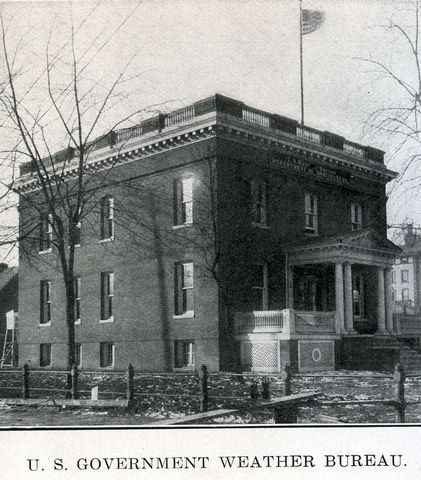 |
|
|
June 29, 1912: A weather "kiosk" was installed in downtown Peoria, on the Court House Square at the corner of Main and Adams Sts. This kiosk contained thermometers, a thermograph, barometer, hygrometer, and recording rain gage. Weather maps, charts, and bulletins were posted daily by Weather Bureau personnel. The kiosk was removed sometime around 1936. |
September 1918: The Peoria Weather Bureau office hires its first female weather observer, Miss Gladys Catlin.
October 1926: The first telephone reports from the Peoria Weather Bureau office were made to air mail fields in Chicago and Springfield.
November 1, 1928: The Springfield Weather Bureau office moved to the Abe Lincoln Hotel, at 5th and Capitol. The site of the old office is demolished in 1929, in preparation for the construction of the new federal courthouse.
| November 1, 1930: The Springfield Weather Bureau office is moved to the new Federal Building at 7th and Monroe Sts. |
 |
1931: The Peoria Weather Bureau office begins 24-hour operations.
1935: The Peoria Weather Bureau begins direct radio broadcasts, through the cooperation of radio station WMBD.
| March 1, 1935: To serve the growing aviation industry, a Weather Bureau Airport Station (WBAS) was opened at the Peoria Municipal Airport. The observing station was located at the Administration Building. Initial observing equipment included a wind gage (anemometer), thermometers for measuring high and low temperature, and a rain gage. |
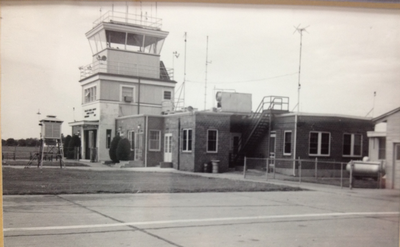
|
November 15, 1935: Another Weather Bureau Airport Station (WBAS) is opened in central Illinois. This one is located in Springfield, at the Southwest Airport (near the current intersection of Chatham Rd. and Westchester Blvd). Hourly weather observations of temperature, wind, pressure, and sky condition are taken.
1936: Weather forecasts for central Illinois continue to originate from the Chicago district office. This office also issued forecasts for all of Illinois, Indiana, Iowa, Michigan, Wisconsin, Minnesota, North and South Dakota, Missouri, Kansas and Nebraska, although the latter 3 states were assigned to a new district office in Kansas City during this year.
November 4, 1937: Precipitation measurements began at the Southwest Airport in Springfield, and the site is designated as a "first-order" station.
June 30, 1940: With the expansion of the aviation industry, the operation of the U.S. Weather Bureau is transferred from the Department of Agriculture to the Department of Commerce.
May 4, 1943: The Weather Bureau operations of the City Office (Bradley campus) in Peoria are merged with the Airport Office.
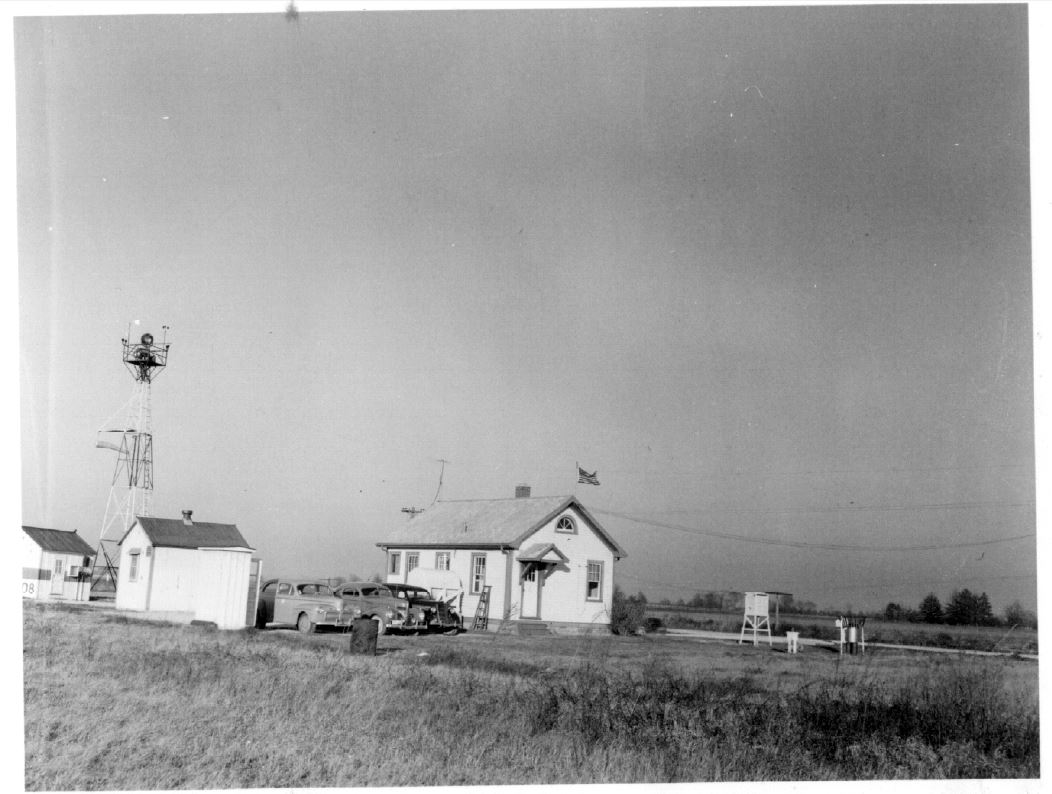 |
January 1, 1944: A Weather Bureau Airport Station began joint operation in Effingham with the Civil Aeronautics Administration (CAA), a forerunner of the FAA. The station had previously been under sole operation by the CAA since 1933. |
August 15, 1944: The Weather Bureau closes its City Office in Peoria.
September 1944: Radiosonde (upper-air) observations begin at Chanute Field in Rantoul. These observations are taken 4 times a day.
February 1, 1947: Operation of the WBAS at Effingham was transferred back to the CAA.
|
|
November 1, 1947: Weather observations from the Southwest Airport in Springfield are transferred to the new Capital Airport, 6 miles to the northeast. The Weather Bureau office is located in the terminal building.
|
April 1, 1951: Operations of the CAA (former WBAS) station in Effingham were moved to the Vandalia airport.
December 1952: A facsimile recorder is installed at the Peoria Weather Bureau office.
1953: The Peoria Weather Bureau office's hours of operation are reduced to 8 am to 6 pm daily.
April 30, 1954: The Weather Bureau closes its City Office in Springfield. The airport station carried on the work of the city office, with 6 people to do the work previously requiring 10 people. The climatological duties of the Springfield office are alleviated in 1955, when the state climatologist position is transferred to work from the University of Illinois.
November 13, 1954: Teletype operations are established at the Peoria Weather Bureau office, for transmitting hourly weather conditions, local summaries, and severe weather warnings.
June 1955: Portions of central and western Illinois come under radar coverage for the first time, with the installation of the WSR-1 radar at Lambert Field in St. Louis, MO.
| September 12, 1956: Upper-air observations are transferred to Peoria from Chanute AFB in Rantoul. Observations were taken 4 times a day until October 1957, when they were cut back to twice a day. The Peoria Weather Bureau office is expanded back to 24 hour operations. |
|
October 1, 1959: The Peoria Weather Bureau office moves to the new Administration Building, 2300 feet west-northwest of the old office.
July 1960: Radar coverage in central and western Illinois is improved with the new WSR-57 radar in St. Louis.
July 13, 1965: The Weather Bureau becomes part of the new Environmental Science Services Administration (ESSA) within the Department of Commerce.
December 14, 1966: The Weather Bureau office in Springfield discontinues its pilot balloon (pibal) observation program.
1967: The ESSA begins to internally refer to the Weather Bureau as the "National Weather Service", but externally the organization is still largely called the Weather Bureau. The district forecast offices were reorganized and divided into State Forecast Offices, with the Illinois SFO located in Chicago.
October 1, 1970: The ESSA is renamed the National Oceanic and Atmospheric Administration (NOAA), and the Weather Bureau is renamed the National Weather Service (NWS). Field offices are redesignated as "Weather Service Forecast Offices" (WSFO, such as Chicago) and "Weather Service Offices" (WSO, such as Peoria and Springfield).
November 1, 1974: Radar coverage over much of central Illinois is improved with the activation of a new radar, the WSR-74S, in Marseilles, in eastern La Salle County.
1976: The Peoria NWS office discontinues its routine weather broadcasts on WMBD radio.
|
|
August 12, 1977: NOAA Weather Radio (NWR) makes its debut in central Illinois, when station WXJ-75 in Springfield goes on the air. Later in the year, WXJ-76 in Champaign debuts on December 1, and WXJ-71 in Peoria on December 21. NWR uses tape-recorded messages, with the ability to broadcast live messages if necessary.
|
August 30, 1977: A new radar was commissioned at Moline, the WSR-74C. This radar, along with the Marseilles radar (and later the Springfield radar), was used for warning issuance by the Peoria NWS, which never had its own radar unit. Remote radar displays, and telephone conversations between the offices, were the methods used by the Peoria staff to accomplish this task.
October 24, 1979: The Peoria NWS office moves to the Business Aviation Building (Byerly Building), 800 feet east-northeast of the old office location.
| November 1979: Teletype operations at the Peoria and Springfield NWS offices began conversion to the new Automation of Field Operations and Services (AFOS) computer network. |
|
March 5, 1980: The Springfield NWS office is relocated to the new Services Building on the north side of the airport grounds.
August 1, 1980: Construction begins on the WSR-74C radar at Capital Airport in Springfield.
|
|
October 16, 1980: The WSR-74C radar is commissioned for use. It is used for local warning operations, and as a supplement to the national network radar system.
|
|
September 30, 1989: The Peoria NWS takes its last hand-written hourly surface observation. The observations were computerized through a PC program called MAPSO (Microcomputer-Aided Paperless Surface Observations) beginning on October 1.
|
April 1990: The upper-air (weather balloon) tracking system in Peoria was upgraded to use a PC, replacing magnetic tapes and a mini-computer.
|
December 1992: Installation of the Automated Surface Observing System (ASOS) began at the Springfield airport on the 1st, and at the Peoria airport on the 10th. ASOS is designed to automate routine hourly weather observations of temperature, weather type, wind, sky condition, and visibility.
|

|
|
|
December 1993: Construction begins on a new NWS Weather Forecast Office at the Logan County Airport in Lincoln. As part of the NWS modernization project, the Lincoln office would assume warning and forecast functions of the existing Peoria and Springfield offices.
|
November 1994: The new NWS Weather Forecast Office in Lincoln is accepted by the government. Initial staff was limited to only a few people, and thus did not have any operational responsibilities.
|
February 9, 1995: Upper-air equipment from the NWS office in Paducah, KY, is moved to the new NWS office in Lincoln. The first upper-air observation in Lincoln is taken on the 15th. Observations are taken twice a day. Because this is the only function of the office at the time, it is not staffed 24 hours a day.
|
|
February 14, 1995: The last upper-air observation is taken at Peoria. The equipment is then relocated to the new NWS office in Davenport, IA.
March 1, 1995: Warning responsibility for 6 counties in west central Illinois is transferred from the Peoria NWS to the Davenport NWS office.
|
|
April 1995: Construction begins on the WSR-88D Doppler radar at the Logan County Airport in Lincoln.
|
May 9, 1995: A tornado passes approximately 2 miles southeast of the new Lincoln NWS office, visible to several staff members at the office. The early stages of this tornado were also visible from the Springfield NWS office, when the tornado was northwest of the city. |
|
May 14, 1995: The first 5 meteorologists report to the Lincoln NWS office. Since warning and forecast responsibilities remain at the Peoria and Springfield offices, these 5 forecasters train on the new WSR-88D radar system and on future forecasting responsibilities.
September 27, 1995: The NWS office in Lincoln begins full-time operations, with transfer of the remaining 10 counties covered by the Peoria NWS office, and of the 18 counties covered by the Springfield office. Additionally, 2 counties are transferred to Lincoln from the St. Louis NWS, and 5 counties are transferred from the Evansville, IN, NWS. Programming of the Peoria, Springfield and Champaign NOAA Weather Radio stations also is transferred to Lincoln, along with the AFOS computer network. The Lincoln NWS office is initially responsible for severe weather warnings and local short-term forecasts for 35 counties.
October 1, 1995: The NWS offices in Peoria and Springfield are officially closed. The ASOS observing system is commissioned for operations at the Peoria Airport. Contract observers oversee the operation of the ASOS for accuracy. Contract observers take manual observations of hourly weather conditions at Springfield.
December 1, 1995: The ASOS observing system is commissioned in Springfield. The contract and control tower personnel oversee operation of ASOS for accuracy.
|
|
January 3, 1996: The WSR-88D Doppler radar is commissioned in Lincoln.
|
April 1, 1996: The Lincoln NWS office assumes responsibility for aviation forecasts for airports at Peoria, Springfield, Decatur, and Champaign. These were previously issued by the Chicago NWS office.
July 1, 1996: The Lincoln NWS assumes aviation route forecast responsibilities for the air routes from Chicago to Springfield to St. Louis, and from Terre Haute to St. Louis.
July 30, 1996: The WSR-74C radar in Springfield is decommissioned.
October 17, 1997: The Lincoln NWS Internet home page makes its debut.
|
June 1998: Installation of the Console Replacement System (CRS) began at the Lincoln NWS office. CRS, nicknamed "NOAA Weather Radio 2000," was designed to replace the labor-intensive, magnetic tape system used for the NOAA Weather Radio broadcasts, by utilizing a synthesized voice and a computer-based console. Phase-in of the automated broadcasts took place the following winter.
|
|
September 12, 1998: The Lincoln NWS conducts an open house of its facilities. Approximately 1,000 people take advantage of a beautiful day to tour the office.
|
|
November 16, 1998: The Advanced Weather Information Processing System (AWIPS) is installed at the Lincoln NWS office. AWIPS allows for greatly increased monitoring capabilities of weather, satellite, and computer model data by forecasters. |
January 1, 1999: A major winter storm paralyzed central Illinois. Several Lincoln NWS staff members were forced to spend 1-2 consecutive days at work, when replacement shifts were unable to reach the office.
July 6, 1999: The Lincoln NWS assumes public forecast responsibility for its 35 counties in central Illinois. These forecasts were previously issued by the Chicago NWS office.
April 2000: NOAA Weather Radio coverage in central Illinois is expanded with the installation of new station WXM-90 near Jacksonville.
October 1, 2000: The AFOS computer system is officially decommissioned by the NWS, having been replaced by AWIPS.
October 20, 2000: A long-awaited NOAA Weather Radio transmitter is installed in southeast Illinois. Station KXI-48 in Newton began transmitting in a 40 mile radius on this date, programmed from the Lincoln NWS office.
February 2001: New NOAA Weather Radio stations debut: KXI-46 in western Shelby County, near Tower Hill, and KXI-47 just south of Paris.
October 2001: NOAA Weather Radio expansion in central Illinois includes new transmitters at Bloomington (KZZ-65, activated on the 10th) and at Galesburg (KZZ-66, activated on the 25th).
February 15, 2005: The Lincoln NWS begins a new aviation forecast for the Bloomington airport.
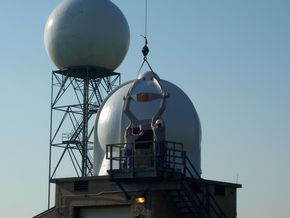 |
July 23, 2007: Balloon tracking equipment was upgraded, to utilize Global Positioning Satellites instead of radio signals. Computers involved in the tracking were upgraded from vintage 1985 models to state-of-the-art PC's. This was part of the nationwide modernization of the upper-air observation network. |
September 29, 2007: The Lincoln NWS issues its last Transcribed Weather Broadcast (TWEB) for the aviation route from Chicago to St. Louis, when TWEB forecasts in the U.S. are discontinued.
| September 29, 2007: The Lincoln NWS conducts its first open house in 9 years. Approximately 700 visitors toured the facility and watched special balloon launches. |
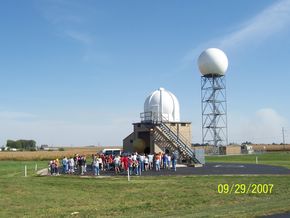 |
June 1, 2011: The Lincoln NWS joins social media, debuting a page on Facebook.
2012: The Lincoln NWS debuts its Twitter social media account.
October 2012: The Lincoln WSR-88D radar is upgraded with dual polarization technology, the most significant upgrade to the radar since it was installed in 1995.
|